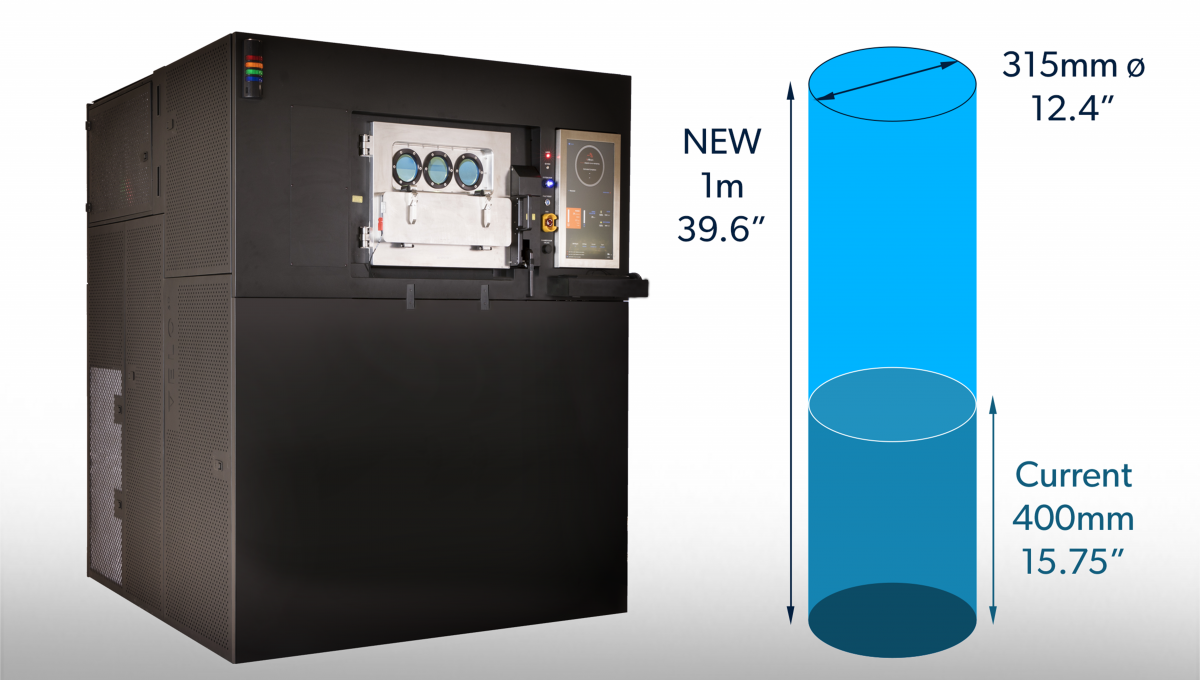The next-generation Sapphire industrial 3D metal printer can print up to 1 m (3.3') in height. Available in the fourth quarter of this year, the laser powder bed fusion additive manufacturing system by Velo3D Inc. of Campbell, California, includes a 315 mm (12.4") dia. build plate, dual 1-kW lasers and in situ optical calibration. The 1-m-tall machine targets a variety of industries, such as aerospace and energy.
“I think there’s a lot of different applications where the geometries that customers are looking for at the end of the day can be very difficult to machine,” said Zach Murphree, vice president of technical partnerships. “And a lot of that has to do with access limitations. So if you think about parts that are manifolds or shrouded impellers or pieces that have kind of internal flow paths, these are generally difficult to get to with a machining tool — or they can be depending on the geometry. And that’s one of the places where we see the technology, 3D metal specifically, being very, very useful.”

The next-generation Sapphire will print parts up to 1 m in height (the blue dimension to the right of the existing model). Image courtesy of Velo3D
For example, he said a 12.7 mm (0.5") dia. gundrilled hole that is 762 mm (30") long and needs to maintain a certain tolerance dimensionally in terms of straightness and where it is in relation to the other surfaces of a part can be challenging to machine. Or perhaps a part requires machining as separate components before being
assembled.
With the Sapphire, Murphree said much complexity can be incorporated into a part from the beginning. Costs, lead times and cycle times may be reduced because fewer steps are demanded to produce parts.
“You can be a really good machine shop and add this to your toolkit without needing to create a center of excellence and hire people who went to school only for additive manufacturing,” he said. “There is calibration and metrology built in to the machine, so the operator can hit a button on the screen and the machine can calibrate itself. It can measure how healthy its optical components are and how accurately the lasers are pointing at different places on the plate, how much is building, how accurate the lasers are relative to each other and do this all without requiring a field service engineer. And so the system that we built is really completely focused on being a production technology that can live on a shop floor next to a five-axis mill and kind of have the same mode of operation.”
For more information about Velo3D, call 408-610-3915 or visit www.velo3d.com.
Contact Details
Related Glossary Terms
- calibration
calibration
Checking measuring instruments and devices against a master set to ensure that, over time, they have remained dimensionally stable and nominally accurate.
- lapping compound( powder)
lapping compound( powder)
Light, abrasive material used for finishing a surface.
- metrology
metrology
Science of measurement; the principles on which precision machining, quality control and inspection are based. See precision machining, measurement.
- milling machine ( mill)
milling machine ( mill)
Runs endmills and arbor-mounted milling cutters. Features include a head with a spindle that drives the cutters; a column, knee and table that provide motion in the three Cartesian axes; and a base that supports the components and houses the cutting-fluid pump and reservoir. The work is mounted on the table and fed into the rotating cutter or endmill to accomplish the milling steps; vertical milling machines also feed endmills into the work by means of a spindle-mounted quill. Models range from small manual machines to big bed-type and duplex mills. All take one of three basic forms: vertical, horizontal or convertible horizontal/vertical. Vertical machines may be knee-type (the table is mounted on a knee that can be elevated) or bed-type (the table is securely supported and only moves horizontally). In general, horizontal machines are bigger and more powerful, while vertical machines are lighter but more versatile and easier to set up and operate.
- tolerance
tolerance
Minimum and maximum amount a workpiece dimension is allowed to vary from a set standard and still be acceptable.


